Advanced application of IR Theory on industrial dispute
VerifiedAdded on 2023/06/04
|18
|4562
|384
AI Summary
This report discusses the industrial dispute occurred at New South Wales, Australia and how conflicts can be resolved using international relations theories. It also recommends measures to prevent industrial disputes and maintain good employment relationships.
Contribute Materials
Your contribution can guide someone’s learning journey. Share your
documents today.
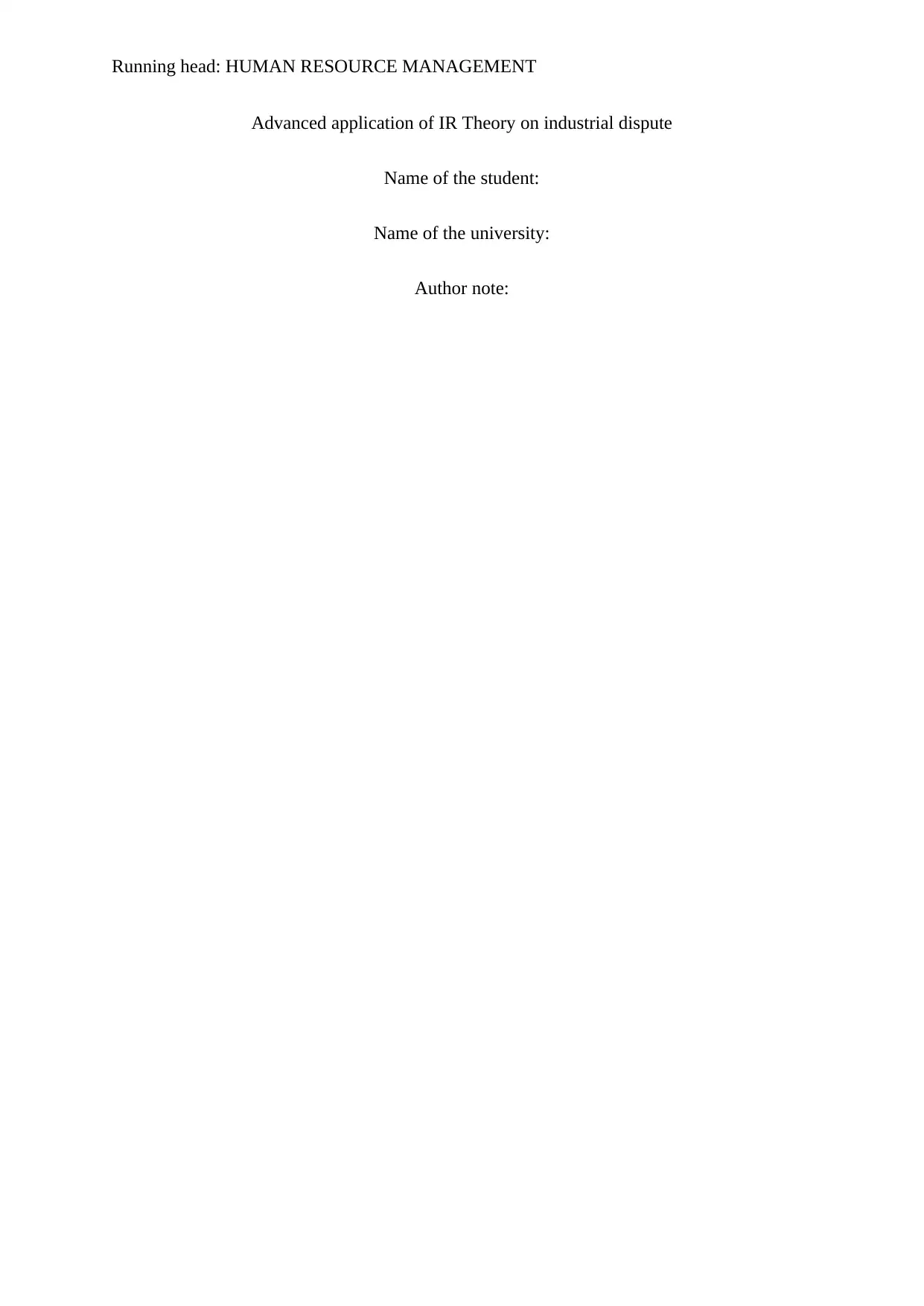
Running head: HUMAN RESOURCE MANAGEMENT
Advanced application of IR Theory on industrial dispute
Name of the student:
Name of the university:
Author note:
Advanced application of IR Theory on industrial dispute
Name of the student:
Name of the university:
Author note:
Secure Best Marks with AI Grader
Need help grading? Try our AI Grader for instant feedback on your assignments.
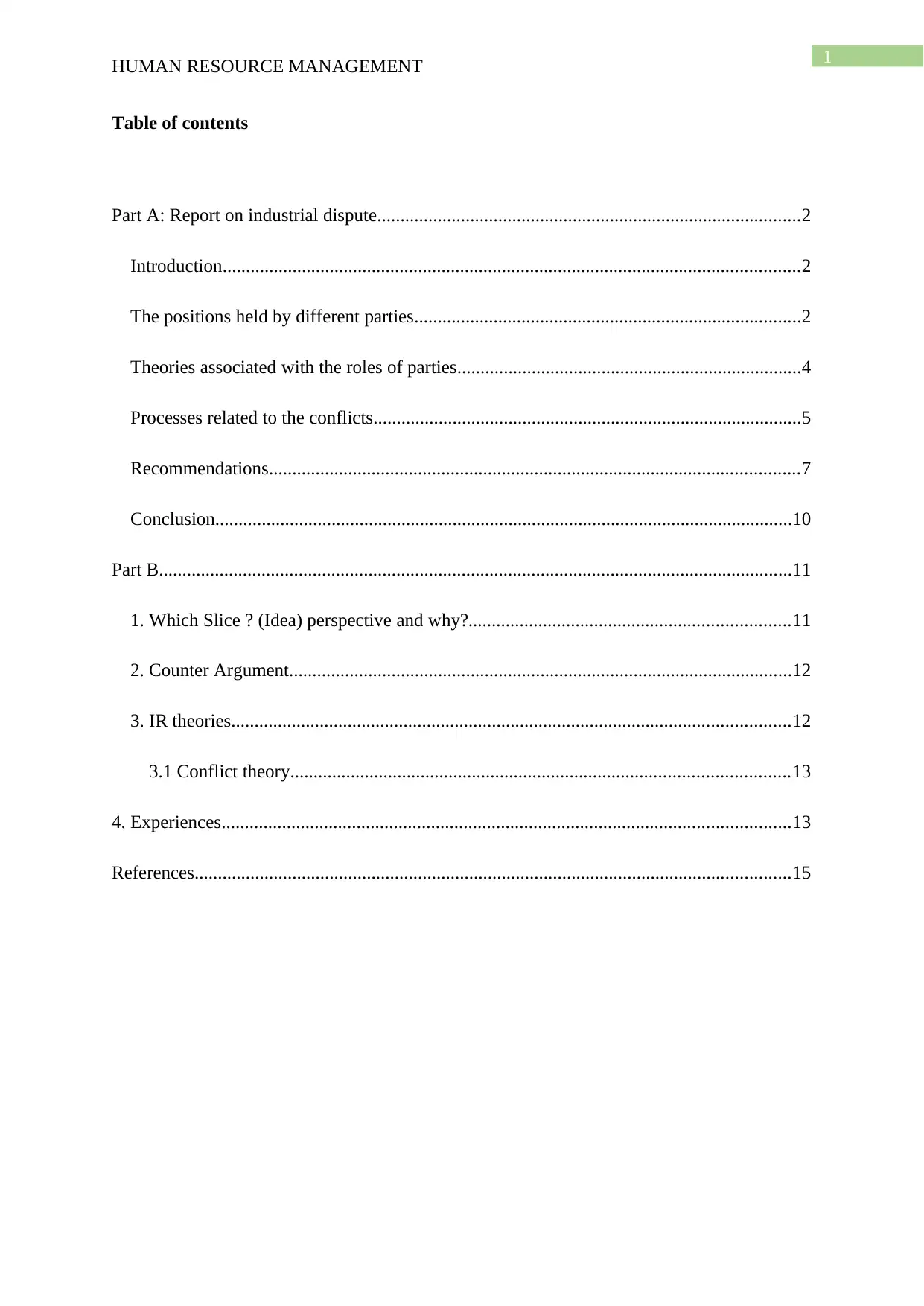
1
HUMAN RESOURCE MANAGEMENT
Table of contents
Part A: Report on industrial dispute...........................................................................................2
Introduction............................................................................................................................2
The positions held by different parties...................................................................................2
Theories associated with the roles of parties..........................................................................4
Processes related to the conflicts............................................................................................5
Recommendations..................................................................................................................7
Conclusion............................................................................................................................10
Part B........................................................................................................................................11
1. Which Slice ? (Idea) perspective and why?.....................................................................11
2. Counter Argument............................................................................................................12
3. IR theories........................................................................................................................12
3.1 Conflict theory...........................................................................................................13
4. Experiences..........................................................................................................................13
References................................................................................................................................15
HUMAN RESOURCE MANAGEMENT
Table of contents
Part A: Report on industrial dispute...........................................................................................2
Introduction............................................................................................................................2
The positions held by different parties...................................................................................2
Theories associated with the roles of parties..........................................................................4
Processes related to the conflicts............................................................................................5
Recommendations..................................................................................................................7
Conclusion............................................................................................................................10
Part B........................................................................................................................................11
1. Which Slice ? (Idea) perspective and why?.....................................................................11
2. Counter Argument............................................................................................................12
3. IR theories........................................................................................................................12
3.1 Conflict theory...........................................................................................................13
4. Experiences..........................................................................................................................13
References................................................................................................................................15
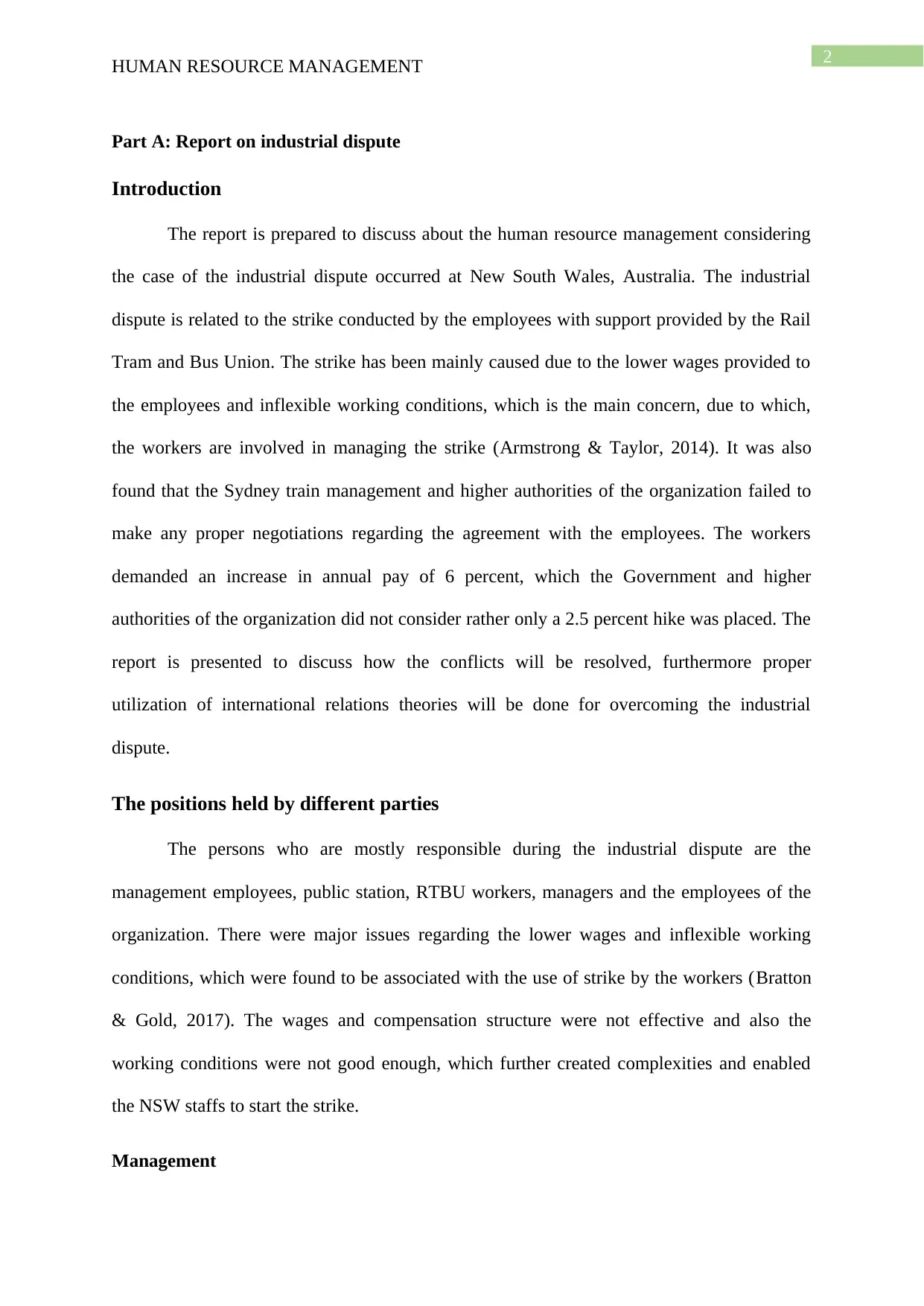
2
HUMAN RESOURCE MANAGEMENT
Part A: Report on industrial dispute
Introduction
The report is prepared to discuss about the human resource management considering
the case of the industrial dispute occurred at New South Wales, Australia. The industrial
dispute is related to the strike conducted by the employees with support provided by the Rail
Tram and Bus Union. The strike has been mainly caused due to the lower wages provided to
the employees and inflexible working conditions, which is the main concern, due to which,
the workers are involved in managing the strike (Armstrong & Taylor, 2014). It was also
found that the Sydney train management and higher authorities of the organization failed to
make any proper negotiations regarding the agreement with the employees. The workers
demanded an increase in annual pay of 6 percent, which the Government and higher
authorities of the organization did not consider rather only a 2.5 percent hike was placed. The
report is presented to discuss how the conflicts will be resolved, furthermore proper
utilization of international relations theories will be done for overcoming the industrial
dispute.
The positions held by different parties
The persons who are mostly responsible during the industrial dispute are the
management employees, public station, RTBU workers, managers and the employees of the
organization. There were major issues regarding the lower wages and inflexible working
conditions, which were found to be associated with the use of strike by the workers (Bratton
& Gold, 2017). The wages and compensation structure were not effective and also the
working conditions were not good enough, which further created complexities and enabled
the NSW staffs to start the strike.
Management
HUMAN RESOURCE MANAGEMENT
Part A: Report on industrial dispute
Introduction
The report is prepared to discuss about the human resource management considering
the case of the industrial dispute occurred at New South Wales, Australia. The industrial
dispute is related to the strike conducted by the employees with support provided by the Rail
Tram and Bus Union. The strike has been mainly caused due to the lower wages provided to
the employees and inflexible working conditions, which is the main concern, due to which,
the workers are involved in managing the strike (Armstrong & Taylor, 2014). It was also
found that the Sydney train management and higher authorities of the organization failed to
make any proper negotiations regarding the agreement with the employees. The workers
demanded an increase in annual pay of 6 percent, which the Government and higher
authorities of the organization did not consider rather only a 2.5 percent hike was placed. The
report is presented to discuss how the conflicts will be resolved, furthermore proper
utilization of international relations theories will be done for overcoming the industrial
dispute.
The positions held by different parties
The persons who are mostly responsible during the industrial dispute are the
management employees, public station, RTBU workers, managers and the employees of the
organization. There were major issues regarding the lower wages and inflexible working
conditions, which were found to be associated with the use of strike by the workers (Bratton
& Gold, 2017). The wages and compensation structure were not effective and also the
working conditions were not good enough, which further created complexities and enabled
the NSW staffs to start the strike.
Management

3
HUMAN RESOURCE MANAGEMENT
The management departments consists of employees who have the authority and
power to manage the human resources properly and at the same time, apply their skills and
knowledge to make the employees understand about the mission statement, vision and goals
to be achieved by the organization, i.e., to serve the clients first and foremost. The
management consisting of the leaders and the human resources’ manager has the right to
monitor the employees’ performances and consider their needs and requirements to be
fulfilled for making them keep motivated and encouraged to perform efficiently (Bos‐Nehles,
Van Riemsdijk & Kees Looise, 2013). The management is also responsible for maintaining a
strong workforce that consists of motivated employees, thereby aiming to enhance the
productivity and create higher engagement of employees altogether for achieving the shared
vision and mission appropriately.
Union
There were conflicts, as found from the case study, regarding the lack of wages and
inappropriate working conditions, which made the employees, start the strike with proper
support by the Union and other regulatory bodies. There were words exchanged between the
Transport Minister and NSW’s Union Secretary, which showed that they both did not pay
any heed to what should be done for overcoming the issue. According to Alfes et al., (2013),
issues were mainly related to the increase in wages that should be done every year, according
to the employees and thus the Union workers started the strike from 12.01 am during the date
of 29th January in 2018. There are various roles and responsibilities managed by the Union
workers to enforce certain laws, rules and regulations for managing the employment
practices. This is mainly done for engaging the workers altogether, allow them to
communication and even unite them by raising a collective voice and stand against the issues
faced due to poor wages and compensation structure along with lack of flexibility in working
conditions in NSW rail. This would also assist in proper sharing and exchange of
HUMAN RESOURCE MANAGEMENT
The management departments consists of employees who have the authority and
power to manage the human resources properly and at the same time, apply their skills and
knowledge to make the employees understand about the mission statement, vision and goals
to be achieved by the organization, i.e., to serve the clients first and foremost. The
management consisting of the leaders and the human resources’ manager has the right to
monitor the employees’ performances and consider their needs and requirements to be
fulfilled for making them keep motivated and encouraged to perform efficiently (Bos‐Nehles,
Van Riemsdijk & Kees Looise, 2013). The management is also responsible for maintaining a
strong workforce that consists of motivated employees, thereby aiming to enhance the
productivity and create higher engagement of employees altogether for achieving the shared
vision and mission appropriately.
Union
There were conflicts, as found from the case study, regarding the lack of wages and
inappropriate working conditions, which made the employees, start the strike with proper
support by the Union and other regulatory bodies. There were words exchanged between the
Transport Minister and NSW’s Union Secretary, which showed that they both did not pay
any heed to what should be done for overcoming the issue. According to Alfes et al., (2013),
issues were mainly related to the increase in wages that should be done every year, according
to the employees and thus the Union workers started the strike from 12.01 am during the date
of 29th January in 2018. There are various roles and responsibilities managed by the Union
workers to enforce certain laws, rules and regulations for managing the employment
practices. This is mainly done for engaging the workers altogether, allow them to
communication and even unite them by raising a collective voice and stand against the issues
faced due to poor wages and compensation structure along with lack of flexibility in working
conditions in NSW rail. This would also assist in proper sharing and exchange of
Secure Best Marks with AI Grader
Need help grading? Try our AI Grader for instant feedback on your assignments.
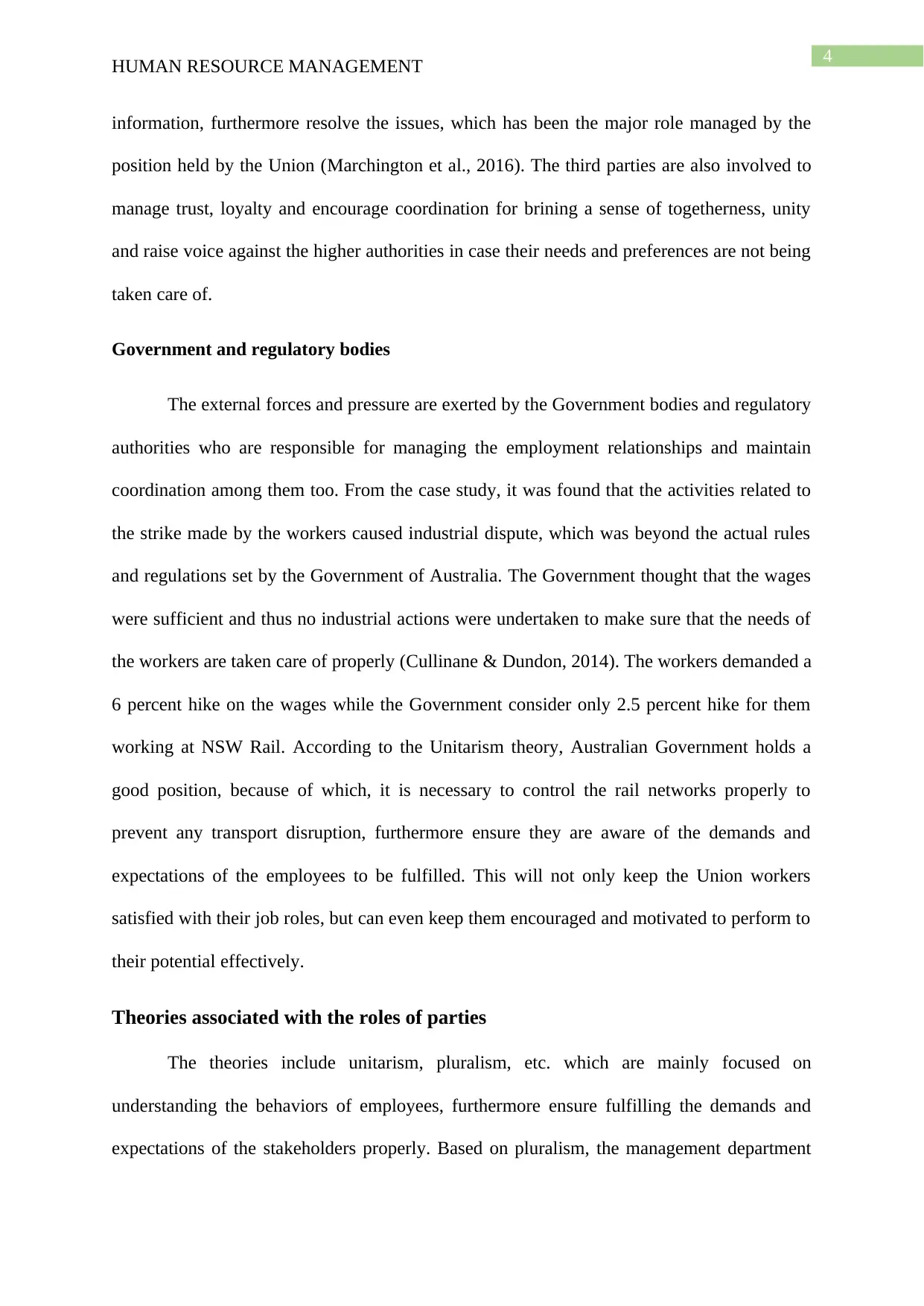
4
HUMAN RESOURCE MANAGEMENT
information, furthermore resolve the issues, which has been the major role managed by the
position held by the Union (Marchington et al., 2016). The third parties are also involved to
manage trust, loyalty and encourage coordination for brining a sense of togetherness, unity
and raise voice against the higher authorities in case their needs and preferences are not being
taken care of.
Government and regulatory bodies
The external forces and pressure are exerted by the Government bodies and regulatory
authorities who are responsible for managing the employment relationships and maintain
coordination among them too. From the case study, it was found that the activities related to
the strike made by the workers caused industrial dispute, which was beyond the actual rules
and regulations set by the Government of Australia. The Government thought that the wages
were sufficient and thus no industrial actions were undertaken to make sure that the needs of
the workers are taken care of properly (Cullinane & Dundon, 2014). The workers demanded a
6 percent hike on the wages while the Government consider only 2.5 percent hike for them
working at NSW Rail. According to the Unitarism theory, Australian Government holds a
good position, because of which, it is necessary to control the rail networks properly to
prevent any transport disruption, furthermore ensure they are aware of the demands and
expectations of the employees to be fulfilled. This will not only keep the Union workers
satisfied with their job roles, but can even keep them encouraged and motivated to perform to
their potential effectively.
Theories associated with the roles of parties
The theories include unitarism, pluralism, etc. which are mainly focused on
understanding the behaviors of employees, furthermore ensure fulfilling the demands and
expectations of the stakeholders properly. Based on pluralism, the management department
HUMAN RESOURCE MANAGEMENT
information, furthermore resolve the issues, which has been the major role managed by the
position held by the Union (Marchington et al., 2016). The third parties are also involved to
manage trust, loyalty and encourage coordination for brining a sense of togetherness, unity
and raise voice against the higher authorities in case their needs and preferences are not being
taken care of.
Government and regulatory bodies
The external forces and pressure are exerted by the Government bodies and regulatory
authorities who are responsible for managing the employment relationships and maintain
coordination among them too. From the case study, it was found that the activities related to
the strike made by the workers caused industrial dispute, which was beyond the actual rules
and regulations set by the Government of Australia. The Government thought that the wages
were sufficient and thus no industrial actions were undertaken to make sure that the needs of
the workers are taken care of properly (Cullinane & Dundon, 2014). The workers demanded a
6 percent hike on the wages while the Government consider only 2.5 percent hike for them
working at NSW Rail. According to the Unitarism theory, Australian Government holds a
good position, because of which, it is necessary to control the rail networks properly to
prevent any transport disruption, furthermore ensure they are aware of the demands and
expectations of the employees to be fulfilled. This will not only keep the Union workers
satisfied with their job roles, but can even keep them encouraged and motivated to perform to
their potential effectively.
Theories associated with the roles of parties
The theories include unitarism, pluralism, etc. which are mainly focused on
understanding the behaviors of employees, furthermore ensure fulfilling the demands and
expectations of the stakeholders properly. Based on pluralism, the management department
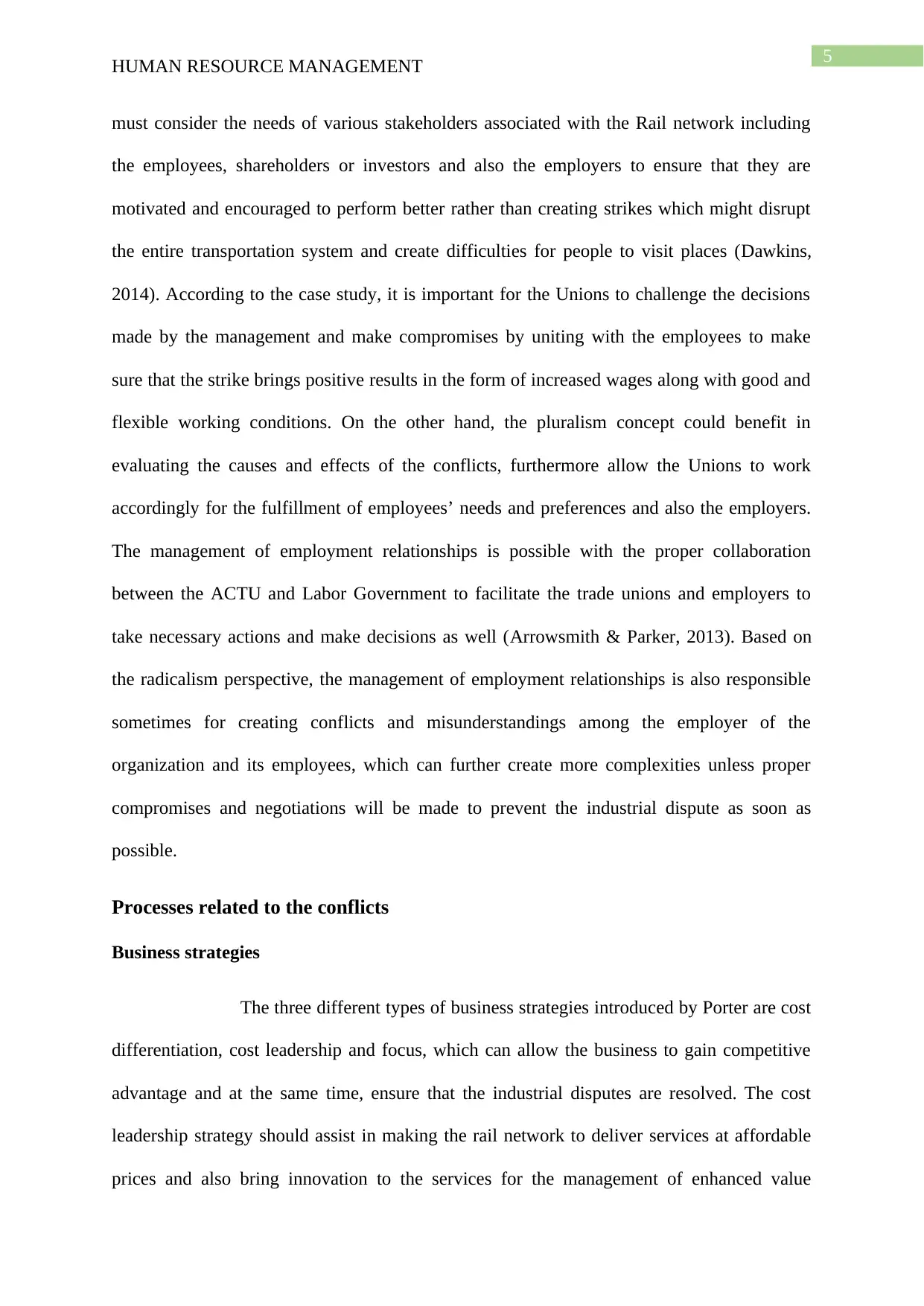
5
HUMAN RESOURCE MANAGEMENT
must consider the needs of various stakeholders associated with the Rail network including
the employees, shareholders or investors and also the employers to ensure that they are
motivated and encouraged to perform better rather than creating strikes which might disrupt
the entire transportation system and create difficulties for people to visit places (Dawkins,
2014). According to the case study, it is important for the Unions to challenge the decisions
made by the management and make compromises by uniting with the employees to make
sure that the strike brings positive results in the form of increased wages along with good and
flexible working conditions. On the other hand, the pluralism concept could benefit in
evaluating the causes and effects of the conflicts, furthermore allow the Unions to work
accordingly for the fulfillment of employees’ needs and preferences and also the employers.
The management of employment relationships is possible with the proper collaboration
between the ACTU and Labor Government to facilitate the trade unions and employers to
take necessary actions and make decisions as well (Arrowsmith & Parker, 2013). Based on
the radicalism perspective, the management of employment relationships is also responsible
sometimes for creating conflicts and misunderstandings among the employer of the
organization and its employees, which can further create more complexities unless proper
compromises and negotiations will be made to prevent the industrial dispute as soon as
possible.
Processes related to the conflicts
Business strategies
The three different types of business strategies introduced by Porter are cost
differentiation, cost leadership and focus, which can allow the business to gain competitive
advantage and at the same time, ensure that the industrial disputes are resolved. The cost
leadership strategy should assist in making the rail network to deliver services at affordable
prices and also bring innovation to the services for the management of enhanced value
HUMAN RESOURCE MANAGEMENT
must consider the needs of various stakeholders associated with the Rail network including
the employees, shareholders or investors and also the employers to ensure that they are
motivated and encouraged to perform better rather than creating strikes which might disrupt
the entire transportation system and create difficulties for people to visit places (Dawkins,
2014). According to the case study, it is important for the Unions to challenge the decisions
made by the management and make compromises by uniting with the employees to make
sure that the strike brings positive results in the form of increased wages along with good and
flexible working conditions. On the other hand, the pluralism concept could benefit in
evaluating the causes and effects of the conflicts, furthermore allow the Unions to work
accordingly for the fulfillment of employees’ needs and preferences and also the employers.
The management of employment relationships is possible with the proper collaboration
between the ACTU and Labor Government to facilitate the trade unions and employers to
take necessary actions and make decisions as well (Arrowsmith & Parker, 2013). Based on
the radicalism perspective, the management of employment relationships is also responsible
sometimes for creating conflicts and misunderstandings among the employer of the
organization and its employees, which can further create more complexities unless proper
compromises and negotiations will be made to prevent the industrial dispute as soon as
possible.
Processes related to the conflicts
Business strategies
The three different types of business strategies introduced by Porter are cost
differentiation, cost leadership and focus, which can allow the business to gain competitive
advantage and at the same time, ensure that the industrial disputes are resolved. The cost
leadership strategy should assist in making the rail network to deliver services at affordable
prices and also bring innovation to the services for the management of enhanced value
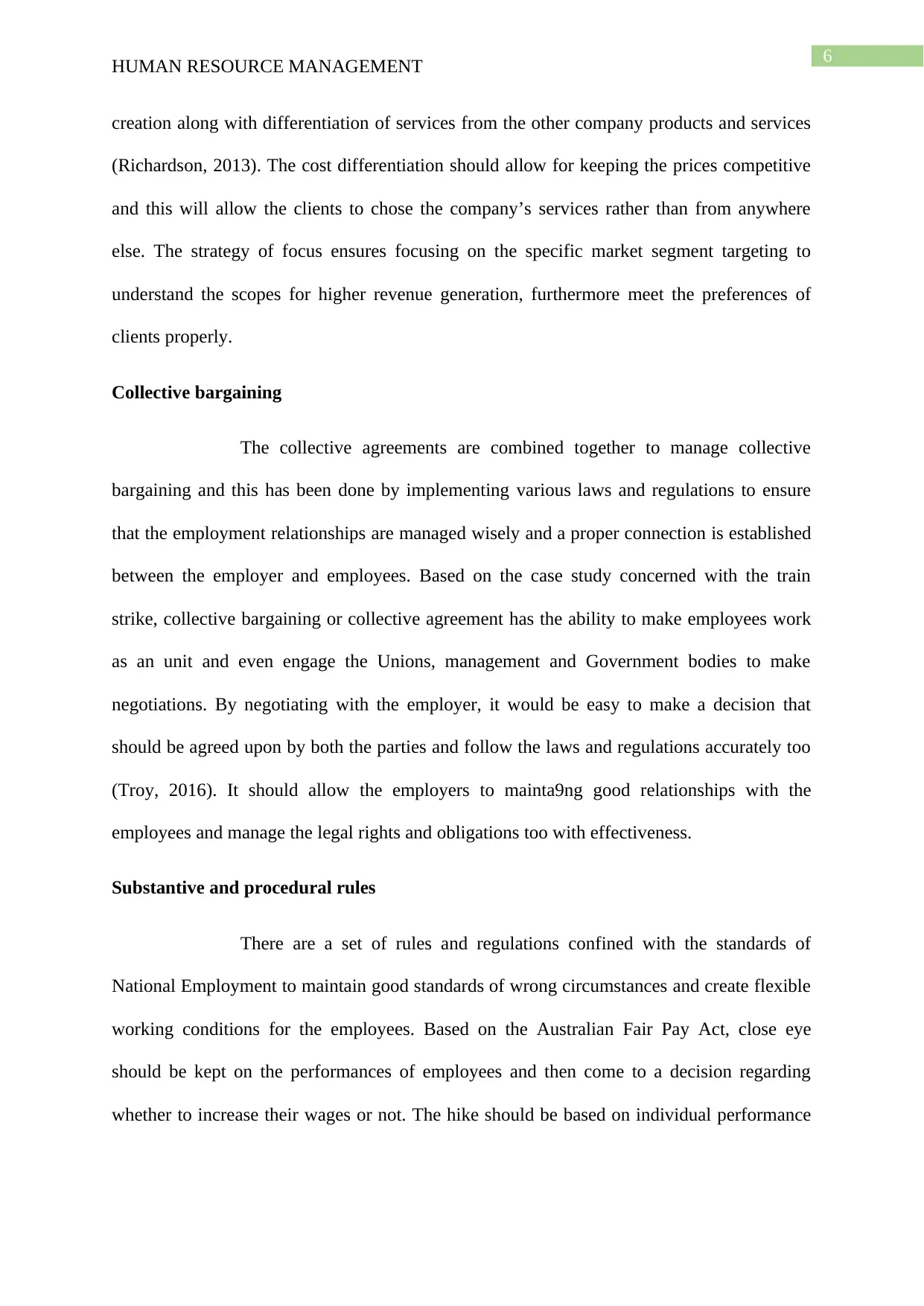
6
HUMAN RESOURCE MANAGEMENT
creation along with differentiation of services from the other company products and services
(Richardson, 2013). The cost differentiation should allow for keeping the prices competitive
and this will allow the clients to chose the company’s services rather than from anywhere
else. The strategy of focus ensures focusing on the specific market segment targeting to
understand the scopes for higher revenue generation, furthermore meet the preferences of
clients properly.
Collective bargaining
The collective agreements are combined together to manage collective
bargaining and this has been done by implementing various laws and regulations to ensure
that the employment relationships are managed wisely and a proper connection is established
between the employer and employees. Based on the case study concerned with the train
strike, collective bargaining or collective agreement has the ability to make employees work
as an unit and even engage the Unions, management and Government bodies to make
negotiations. By negotiating with the employer, it would be easy to make a decision that
should be agreed upon by both the parties and follow the laws and regulations accurately too
(Troy, 2016). It should allow the employers to mainta9ng good relationships with the
employees and manage the legal rights and obligations too with effectiveness.
Substantive and procedural rules
There are a set of rules and regulations confined with the standards of
National Employment to maintain good standards of wrong circumstances and create flexible
working conditions for the employees. Based on the Australian Fair Pay Act, close eye
should be kept on the performances of employees and then come to a decision regarding
whether to increase their wages or not. The hike should be based on individual performance
HUMAN RESOURCE MANAGEMENT
creation along with differentiation of services from the other company products and services
(Richardson, 2013). The cost differentiation should allow for keeping the prices competitive
and this will allow the clients to chose the company’s services rather than from anywhere
else. The strategy of focus ensures focusing on the specific market segment targeting to
understand the scopes for higher revenue generation, furthermore meet the preferences of
clients properly.
Collective bargaining
The collective agreements are combined together to manage collective
bargaining and this has been done by implementing various laws and regulations to ensure
that the employment relationships are managed wisely and a proper connection is established
between the employer and employees. Based on the case study concerned with the train
strike, collective bargaining or collective agreement has the ability to make employees work
as an unit and even engage the Unions, management and Government bodies to make
negotiations. By negotiating with the employer, it would be easy to make a decision that
should be agreed upon by both the parties and follow the laws and regulations accurately too
(Troy, 2016). It should allow the employers to mainta9ng good relationships with the
employees and manage the legal rights and obligations too with effectiveness.
Substantive and procedural rules
There are a set of rules and regulations confined with the standards of
National Employment to maintain good standards of wrong circumstances and create flexible
working conditions for the employees. Based on the Australian Fair Pay Act, close eye
should be kept on the performances of employees and then come to a decision regarding
whether to increase their wages or not. The hike should be based on individual performance
Paraphrase This Document
Need a fresh take? Get an instant paraphrase of this document with our AI Paraphraser
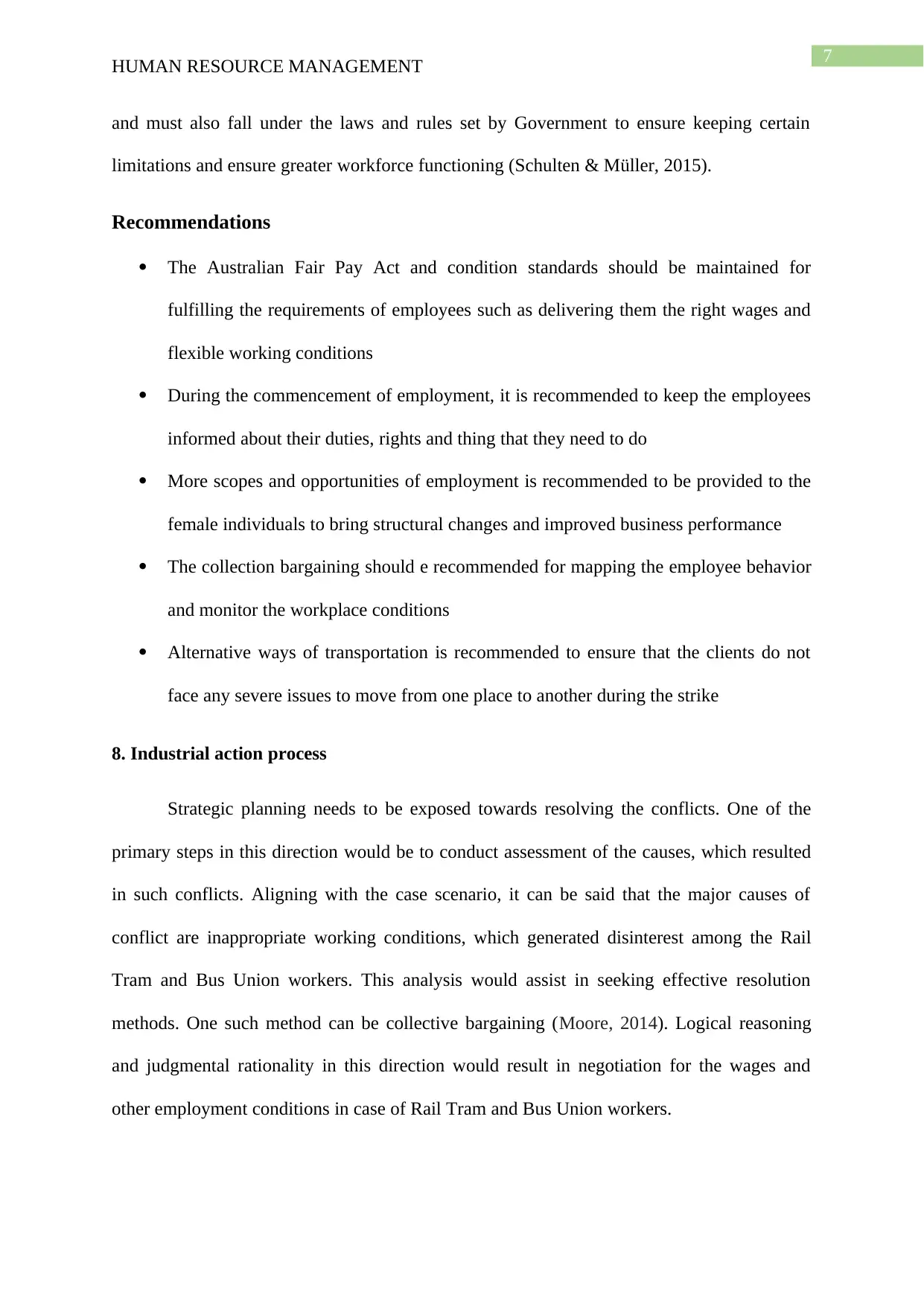
7
HUMAN RESOURCE MANAGEMENT
and must also fall under the laws and rules set by Government to ensure keeping certain
limitations and ensure greater workforce functioning (Schulten & Müller, 2015).
Recommendations
The Australian Fair Pay Act and condition standards should be maintained for
fulfilling the requirements of employees such as delivering them the right wages and
flexible working conditions
During the commencement of employment, it is recommended to keep the employees
informed about their duties, rights and thing that they need to do
More scopes and opportunities of employment is recommended to be provided to the
female individuals to bring structural changes and improved business performance
The collection bargaining should e recommended for mapping the employee behavior
and monitor the workplace conditions
Alternative ways of transportation is recommended to ensure that the clients do not
face any severe issues to move from one place to another during the strike
8. Industrial action process
Strategic planning needs to be exposed towards resolving the conflicts. One of the
primary steps in this direction would be to conduct assessment of the causes, which resulted
in such conflicts. Aligning with the case scenario, it can be said that the major causes of
conflict are inappropriate working conditions, which generated disinterest among the Rail
Tram and Bus Union workers. This analysis would assist in seeking effective resolution
methods. One such method can be collective bargaining (Moore, 2014). Logical reasoning
and judgmental rationality in this direction would result in negotiation for the wages and
other employment conditions in case of Rail Tram and Bus Union workers.
HUMAN RESOURCE MANAGEMENT
and must also fall under the laws and rules set by Government to ensure keeping certain
limitations and ensure greater workforce functioning (Schulten & Müller, 2015).
Recommendations
The Australian Fair Pay Act and condition standards should be maintained for
fulfilling the requirements of employees such as delivering them the right wages and
flexible working conditions
During the commencement of employment, it is recommended to keep the employees
informed about their duties, rights and thing that they need to do
More scopes and opportunities of employment is recommended to be provided to the
female individuals to bring structural changes and improved business performance
The collection bargaining should e recommended for mapping the employee behavior
and monitor the workplace conditions
Alternative ways of transportation is recommended to ensure that the clients do not
face any severe issues to move from one place to another during the strike
8. Industrial action process
Strategic planning needs to be exposed towards resolving the conflicts. One of the
primary steps in this direction would be to conduct assessment of the causes, which resulted
in such conflicts. Aligning with the case scenario, it can be said that the major causes of
conflict are inappropriate working conditions, which generated disinterest among the Rail
Tram and Bus Union workers. This analysis would assist in seeking effective resolution
methods. One such method can be collective bargaining (Moore, 2014). Logical reasoning
and judgmental rationality in this direction would result in negotiation for the wages and
other employment conditions in case of Rail Tram and Bus Union workers.
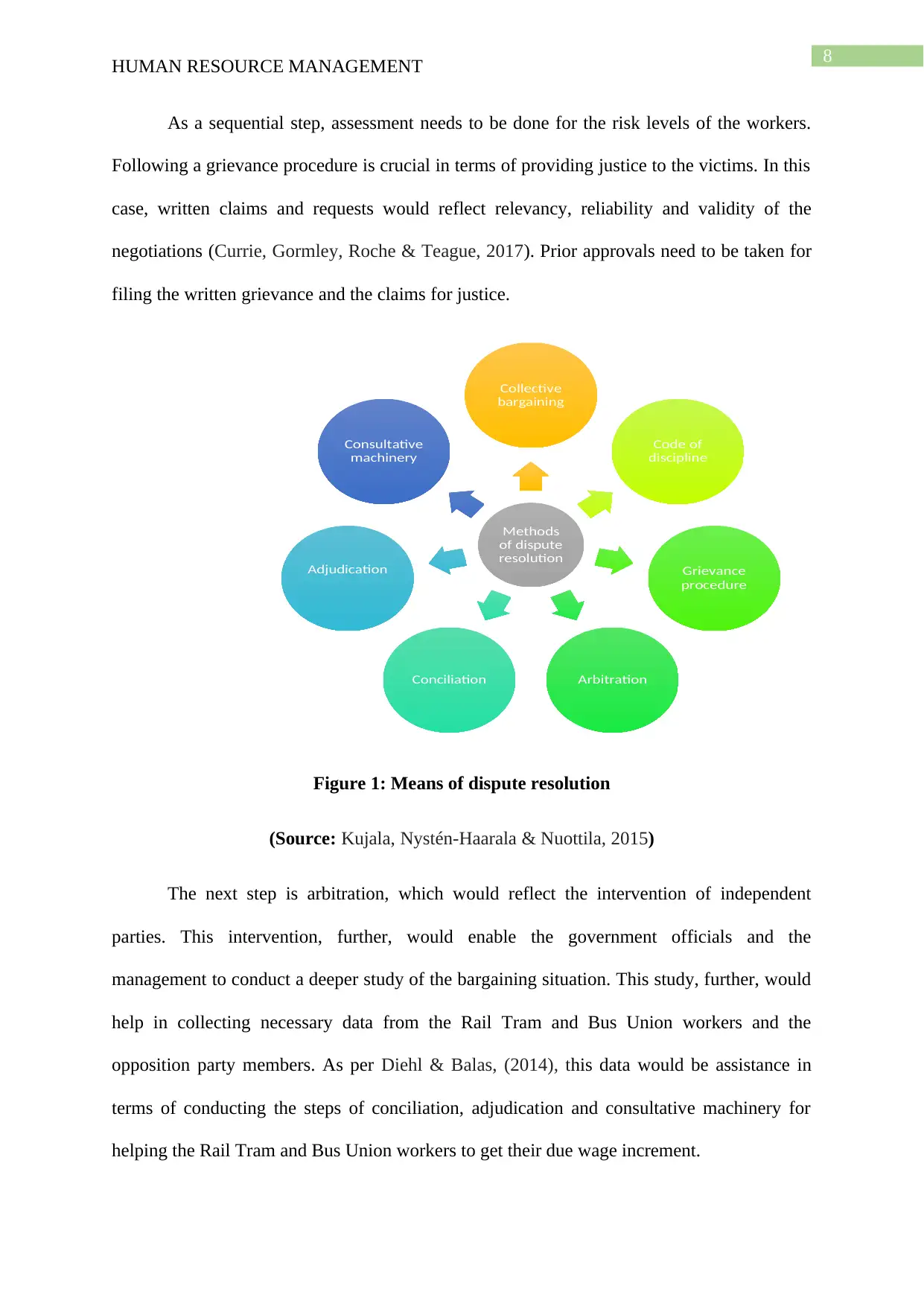
8
HUMAN RESOURCE MANAGEMENT
As a sequential step, assessment needs to be done for the risk levels of the workers.
Following a grievance procedure is crucial in terms of providing justice to the victims. In this
case, written claims and requests would reflect relevancy, reliability and validity of the
negotiations (Currie, Gormley, Roche & Teague, 2017). Prior approvals need to be taken for
filing the written grievance and the claims for justice.
Figure 1: Means of dispute resolution
(Source: Kujala, Nystén-Haarala & Nuottila, 2015)
The next step is arbitration, which would reflect the intervention of independent
parties. This intervention, further, would enable the government officials and the
management to conduct a deeper study of the bargaining situation. This study, further, would
help in collecting necessary data from the Rail Tram and Bus Union workers and the
opposition party members. As per Diehl & Balas, (2014), this data would be assistance in
terms of conducting the steps of conciliation, adjudication and consultative machinery for
helping the Rail Tram and Bus Union workers to get their due wage increment.
Methods
of dispute
resolution
Collective
bargaining
Code of
discipline
Grievance
procedure
ArbitrationConciliation
Adjudication
Consultative
machinery
HUMAN RESOURCE MANAGEMENT
As a sequential step, assessment needs to be done for the risk levels of the workers.
Following a grievance procedure is crucial in terms of providing justice to the victims. In this
case, written claims and requests would reflect relevancy, reliability and validity of the
negotiations (Currie, Gormley, Roche & Teague, 2017). Prior approvals need to be taken for
filing the written grievance and the claims for justice.
Figure 1: Means of dispute resolution
(Source: Kujala, Nystén-Haarala & Nuottila, 2015)
The next step is arbitration, which would reflect the intervention of independent
parties. This intervention, further, would enable the government officials and the
management to conduct a deeper study of the bargaining situation. This study, further, would
help in collecting necessary data from the Rail Tram and Bus Union workers and the
opposition party members. As per Diehl & Balas, (2014), this data would be assistance in
terms of conducting the steps of conciliation, adjudication and consultative machinery for
helping the Rail Tram and Bus Union workers to get their due wage increment.
Methods
of dispute
resolution
Collective
bargaining
Code of
discipline
Grievance
procedure
ArbitrationConciliation
Adjudication
Consultative
machinery
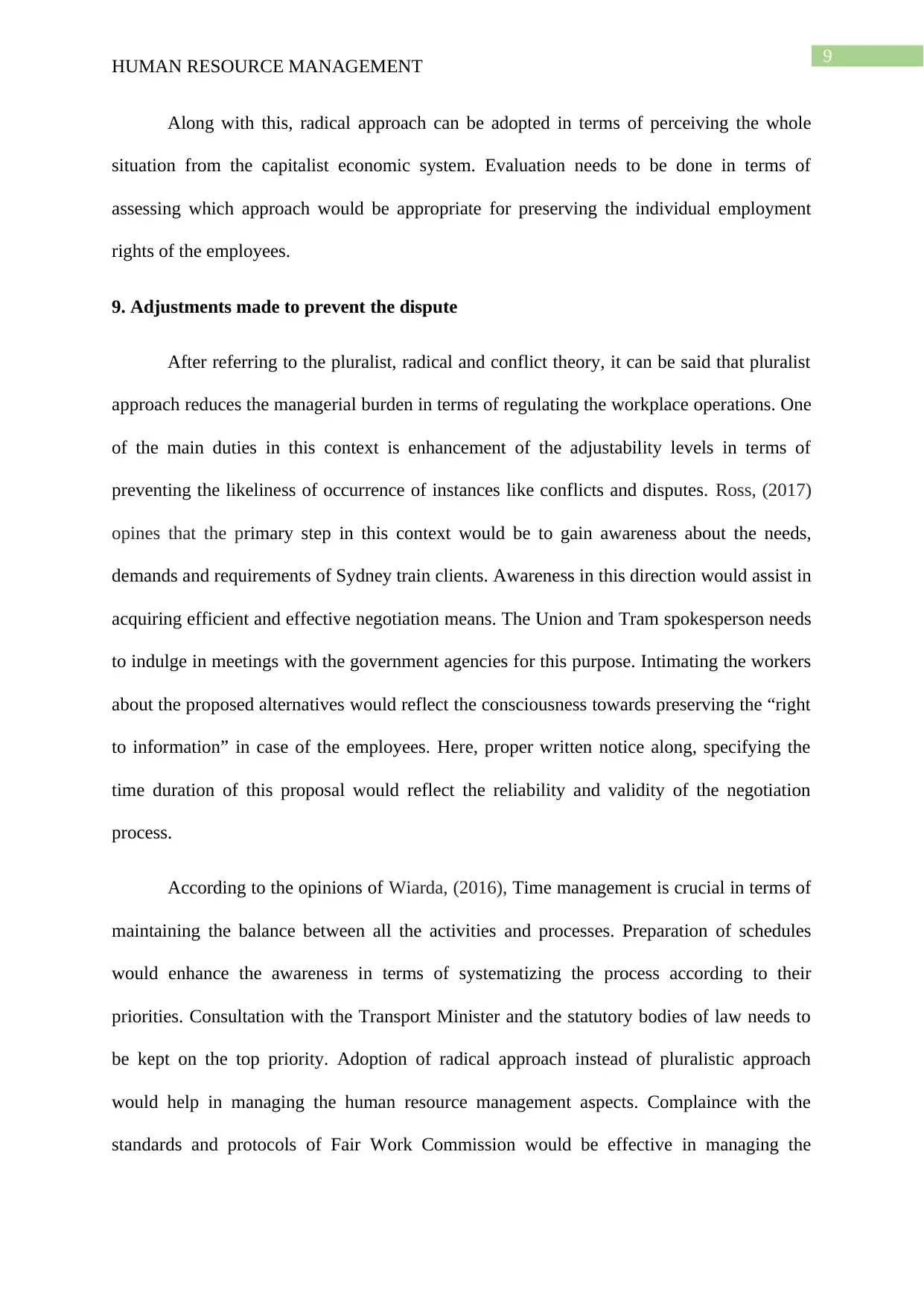
9
HUMAN RESOURCE MANAGEMENT
Along with this, radical approach can be adopted in terms of perceiving the whole
situation from the capitalist economic system. Evaluation needs to be done in terms of
assessing which approach would be appropriate for preserving the individual employment
rights of the employees.
9. Adjustments made to prevent the dispute
After referring to the pluralist, radical and conflict theory, it can be said that pluralist
approach reduces the managerial burden in terms of regulating the workplace operations. One
of the main duties in this context is enhancement of the adjustability levels in terms of
preventing the likeliness of occurrence of instances like conflicts and disputes. Ross, (2017)
opines that the primary step in this context would be to gain awareness about the needs,
demands and requirements of Sydney train clients. Awareness in this direction would assist in
acquiring efficient and effective negotiation means. The Union and Tram spokesperson needs
to indulge in meetings with the government agencies for this purpose. Intimating the workers
about the proposed alternatives would reflect the consciousness towards preserving the “right
to information” in case of the employees. Here, proper written notice along, specifying the
time duration of this proposal would reflect the reliability and validity of the negotiation
process.
According to the opinions of Wiarda, (2016), Time management is crucial in terms of
maintaining the balance between all the activities and processes. Preparation of schedules
would enhance the awareness in terms of systematizing the process according to their
priorities. Consultation with the Transport Minister and the statutory bodies of law needs to
be kept on the top priority. Adoption of radical approach instead of pluralistic approach
would help in managing the human resource management aspects. Complaince with the
standards and protocols of Fair Work Commission would be effective in managing the
HUMAN RESOURCE MANAGEMENT
Along with this, radical approach can be adopted in terms of perceiving the whole
situation from the capitalist economic system. Evaluation needs to be done in terms of
assessing which approach would be appropriate for preserving the individual employment
rights of the employees.
9. Adjustments made to prevent the dispute
After referring to the pluralist, radical and conflict theory, it can be said that pluralist
approach reduces the managerial burden in terms of regulating the workplace operations. One
of the main duties in this context is enhancement of the adjustability levels in terms of
preventing the likeliness of occurrence of instances like conflicts and disputes. Ross, (2017)
opines that the primary step in this context would be to gain awareness about the needs,
demands and requirements of Sydney train clients. Awareness in this direction would assist in
acquiring efficient and effective negotiation means. The Union and Tram spokesperson needs
to indulge in meetings with the government agencies for this purpose. Intimating the workers
about the proposed alternatives would reflect the consciousness towards preserving the “right
to information” in case of the employees. Here, proper written notice along, specifying the
time duration of this proposal would reflect the reliability and validity of the negotiation
process.
According to the opinions of Wiarda, (2016), Time management is crucial in terms of
maintaining the balance between all the activities and processes. Preparation of schedules
would enhance the awareness in terms of systematizing the process according to their
priorities. Consultation with the Transport Minister and the statutory bodies of law needs to
be kept on the top priority. Adoption of radical approach instead of pluralistic approach
would help in managing the human resource management aspects. Complaince with the
standards and protocols of Fair Work Commission would be effective in managing the
Secure Best Marks with AI Grader
Need help grading? Try our AI Grader for instant feedback on your assignments.
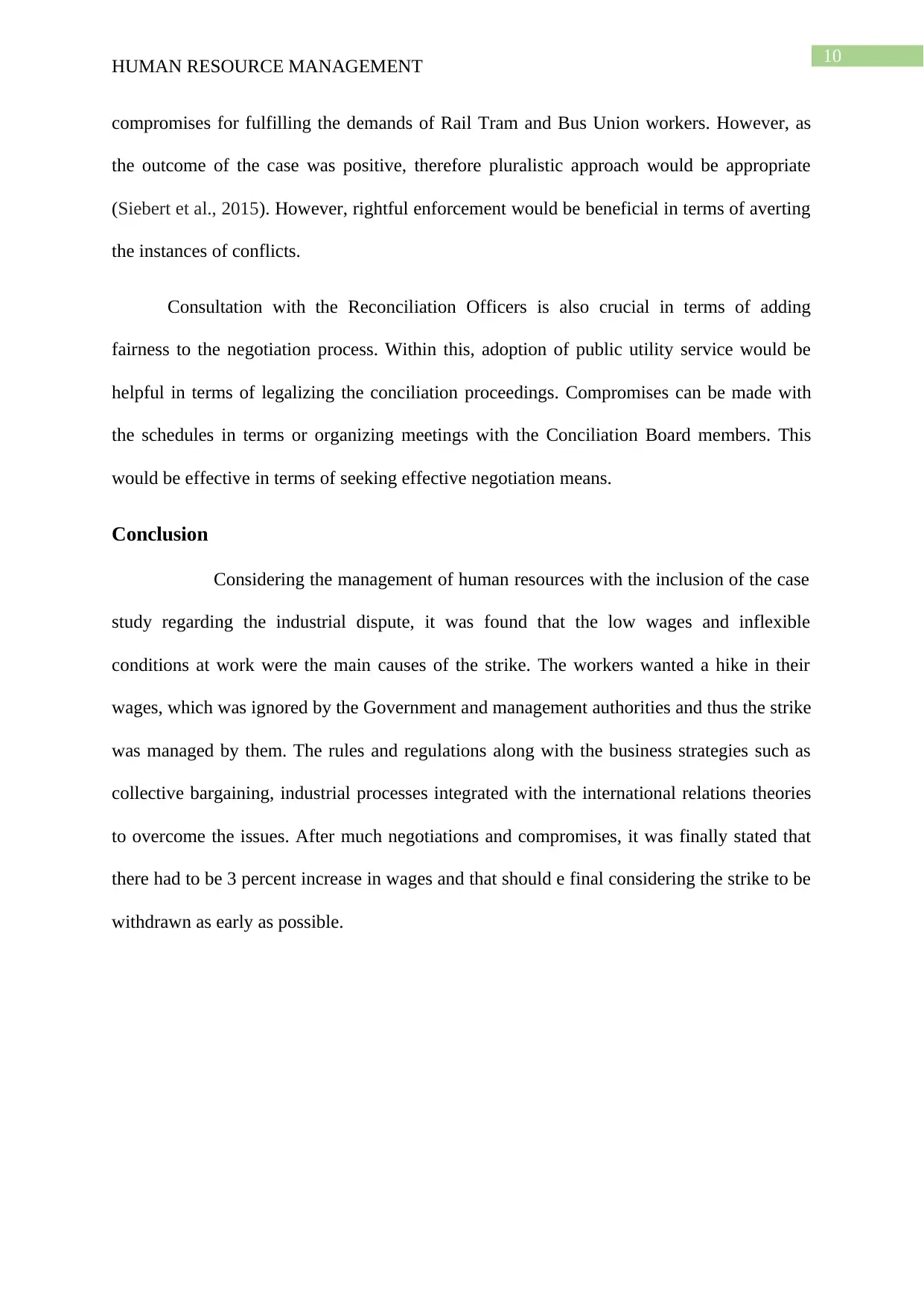
10
HUMAN RESOURCE MANAGEMENT
compromises for fulfilling the demands of Rail Tram and Bus Union workers. However, as
the outcome of the case was positive, therefore pluralistic approach would be appropriate
(Siebert et al., 2015). However, rightful enforcement would be beneficial in terms of averting
the instances of conflicts.
Consultation with the Reconciliation Officers is also crucial in terms of adding
fairness to the negotiation process. Within this, adoption of public utility service would be
helpful in terms of legalizing the conciliation proceedings. Compromises can be made with
the schedules in terms or organizing meetings with the Conciliation Board members. This
would be effective in terms of seeking effective negotiation means.
Conclusion
Considering the management of human resources with the inclusion of the case
study regarding the industrial dispute, it was found that the low wages and inflexible
conditions at work were the main causes of the strike. The workers wanted a hike in their
wages, which was ignored by the Government and management authorities and thus the strike
was managed by them. The rules and regulations along with the business strategies such as
collective bargaining, industrial processes integrated with the international relations theories
to overcome the issues. After much negotiations and compromises, it was finally stated that
there had to be 3 percent increase in wages and that should e final considering the strike to be
withdrawn as early as possible.
HUMAN RESOURCE MANAGEMENT
compromises for fulfilling the demands of Rail Tram and Bus Union workers. However, as
the outcome of the case was positive, therefore pluralistic approach would be appropriate
(Siebert et al., 2015). However, rightful enforcement would be beneficial in terms of averting
the instances of conflicts.
Consultation with the Reconciliation Officers is also crucial in terms of adding
fairness to the negotiation process. Within this, adoption of public utility service would be
helpful in terms of legalizing the conciliation proceedings. Compromises can be made with
the schedules in terms or organizing meetings with the Conciliation Board members. This
would be effective in terms of seeking effective negotiation means.
Conclusion
Considering the management of human resources with the inclusion of the case
study regarding the industrial dispute, it was found that the low wages and inflexible
conditions at work were the main causes of the strike. The workers wanted a hike in their
wages, which was ignored by the Government and management authorities and thus the strike
was managed by them. The rules and regulations along with the business strategies such as
collective bargaining, industrial processes integrated with the international relations theories
to overcome the issues. After much negotiations and compromises, it was finally stated that
there had to be 3 percent increase in wages and that should e final considering the strike to be
withdrawn as early as possible.
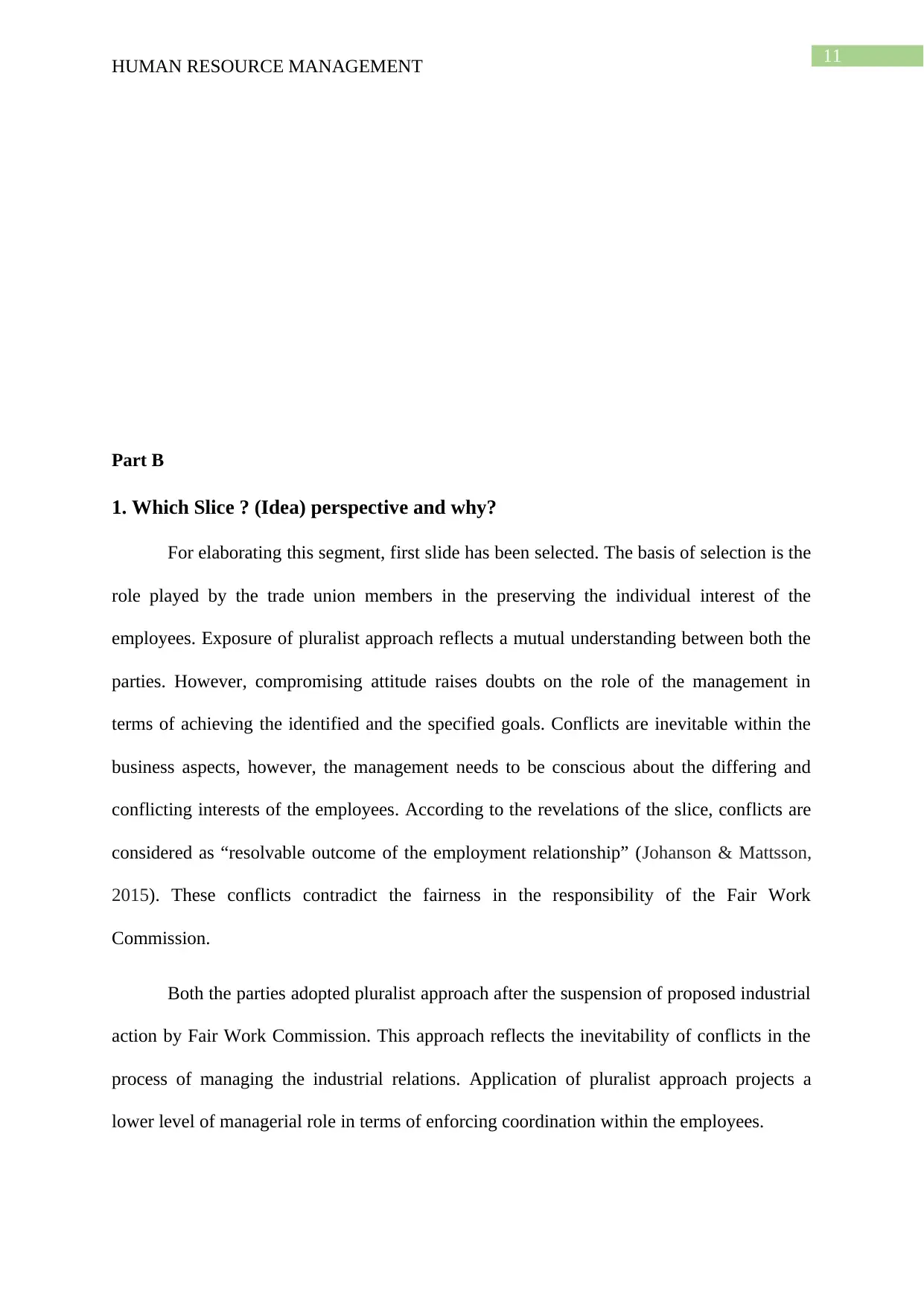
11
HUMAN RESOURCE MANAGEMENT
Part B
1. Which Slice ? (Idea) perspective and why?
For elaborating this segment, first slide has been selected. The basis of selection is the
role played by the trade union members in the preserving the individual interest of the
employees. Exposure of pluralist approach reflects a mutual understanding between both the
parties. However, compromising attitude raises doubts on the role of the management in
terms of achieving the identified and the specified goals. Conflicts are inevitable within the
business aspects, however, the management needs to be conscious about the differing and
conflicting interests of the employees. According to the revelations of the slice, conflicts are
considered as “resolvable outcome of the employment relationship” (Johanson & Mattsson,
2015). These conflicts contradict the fairness in the responsibility of the Fair Work
Commission.
Both the parties adopted pluralist approach after the suspension of proposed industrial
action by Fair Work Commission. This approach reflects the inevitability of conflicts in the
process of managing the industrial relations. Application of pluralist approach projects a
lower level of managerial role in terms of enforcing coordination within the employees.
HUMAN RESOURCE MANAGEMENT
Part B
1. Which Slice ? (Idea) perspective and why?
For elaborating this segment, first slide has been selected. The basis of selection is the
role played by the trade union members in the preserving the individual interest of the
employees. Exposure of pluralist approach reflects a mutual understanding between both the
parties. However, compromising attitude raises doubts on the role of the management in
terms of achieving the identified and the specified goals. Conflicts are inevitable within the
business aspects, however, the management needs to be conscious about the differing and
conflicting interests of the employees. According to the revelations of the slice, conflicts are
considered as “resolvable outcome of the employment relationship” (Johanson & Mattsson,
2015). These conflicts contradict the fairness in the responsibility of the Fair Work
Commission.
Both the parties adopted pluralist approach after the suspension of proposed industrial
action by Fair Work Commission. This approach reflects the inevitability of conflicts in the
process of managing the industrial relations. Application of pluralist approach projects a
lower level of managerial role in terms of enforcing coordination within the employees.
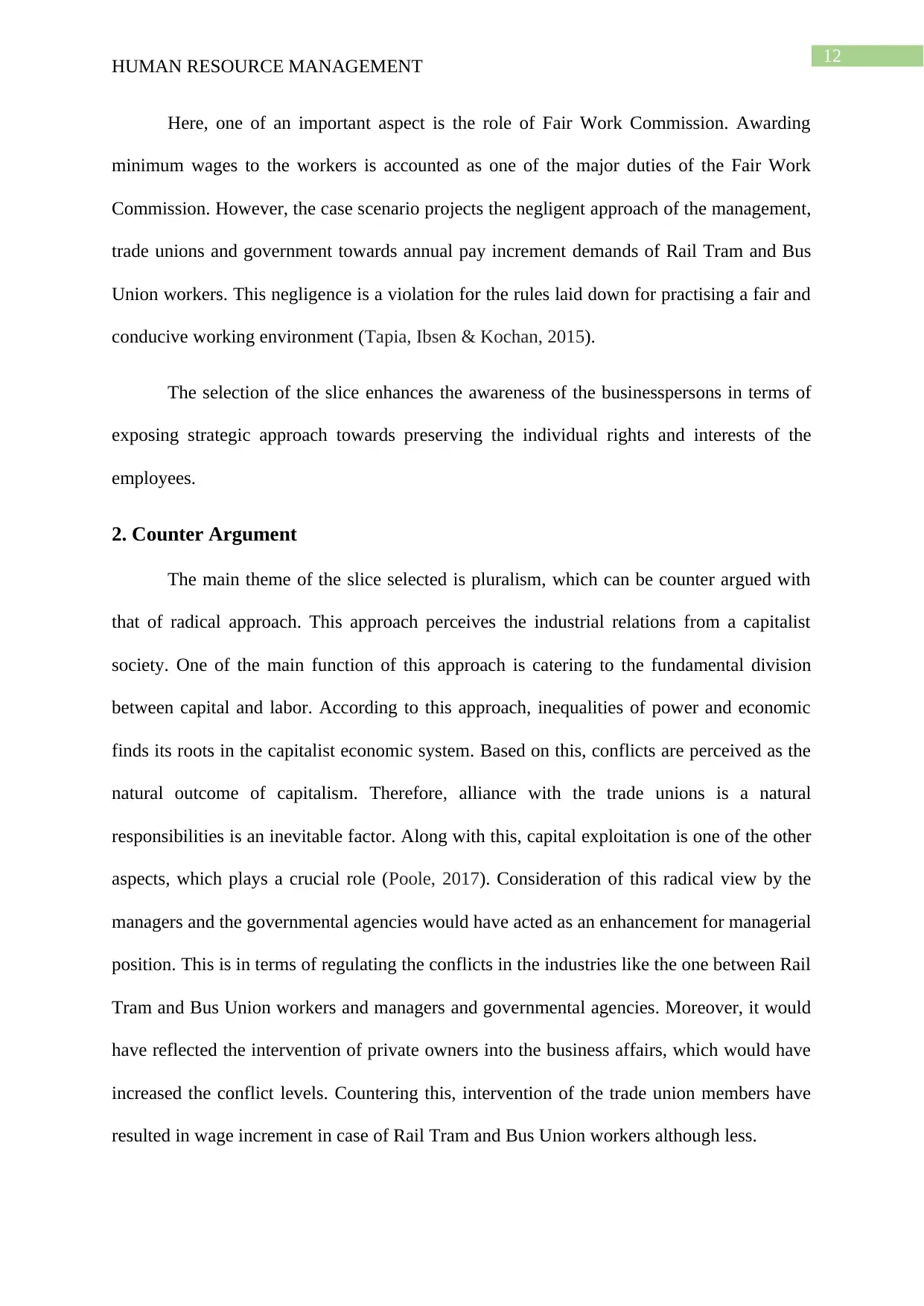
12
HUMAN RESOURCE MANAGEMENT
Here, one of an important aspect is the role of Fair Work Commission. Awarding
minimum wages to the workers is accounted as one of the major duties of the Fair Work
Commission. However, the case scenario projects the negligent approach of the management,
trade unions and government towards annual pay increment demands of Rail Tram and Bus
Union workers. This negligence is a violation for the rules laid down for practising a fair and
conducive working environment (Tapia, Ibsen & Kochan, 2015).
The selection of the slice enhances the awareness of the businesspersons in terms of
exposing strategic approach towards preserving the individual rights and interests of the
employees.
2. Counter Argument
The main theme of the slice selected is pluralism, which can be counter argued with
that of radical approach. This approach perceives the industrial relations from a capitalist
society. One of the main function of this approach is catering to the fundamental division
between capital and labor. According to this approach, inequalities of power and economic
finds its roots in the capitalist economic system. Based on this, conflicts are perceived as the
natural outcome of capitalism. Therefore, alliance with the trade unions is a natural
responsibilities is an inevitable factor. Along with this, capital exploitation is one of the other
aspects, which plays a crucial role (Poole, 2017). Consideration of this radical view by the
managers and the governmental agencies would have acted as an enhancement for managerial
position. This is in terms of regulating the conflicts in the industries like the one between Rail
Tram and Bus Union workers and managers and governmental agencies. Moreover, it would
have reflected the intervention of private owners into the business affairs, which would have
increased the conflict levels. Countering this, intervention of the trade union members have
resulted in wage increment in case of Rail Tram and Bus Union workers although less.
HUMAN RESOURCE MANAGEMENT
Here, one of an important aspect is the role of Fair Work Commission. Awarding
minimum wages to the workers is accounted as one of the major duties of the Fair Work
Commission. However, the case scenario projects the negligent approach of the management,
trade unions and government towards annual pay increment demands of Rail Tram and Bus
Union workers. This negligence is a violation for the rules laid down for practising a fair and
conducive working environment (Tapia, Ibsen & Kochan, 2015).
The selection of the slice enhances the awareness of the businesspersons in terms of
exposing strategic approach towards preserving the individual rights and interests of the
employees.
2. Counter Argument
The main theme of the slice selected is pluralism, which can be counter argued with
that of radical approach. This approach perceives the industrial relations from a capitalist
society. One of the main function of this approach is catering to the fundamental division
between capital and labor. According to this approach, inequalities of power and economic
finds its roots in the capitalist economic system. Based on this, conflicts are perceived as the
natural outcome of capitalism. Therefore, alliance with the trade unions is a natural
responsibilities is an inevitable factor. Along with this, capital exploitation is one of the other
aspects, which plays a crucial role (Poole, 2017). Consideration of this radical view by the
managers and the governmental agencies would have acted as an enhancement for managerial
position. This is in terms of regulating the conflicts in the industries like the one between Rail
Tram and Bus Union workers and managers and governmental agencies. Moreover, it would
have reflected the intervention of private owners into the business affairs, which would have
increased the conflict levels. Countering this, intervention of the trade union members have
resulted in wage increment in case of Rail Tram and Bus Union workers although less.
Paraphrase This Document
Need a fresh take? Get an instant paraphrase of this document with our AI Paraphraser
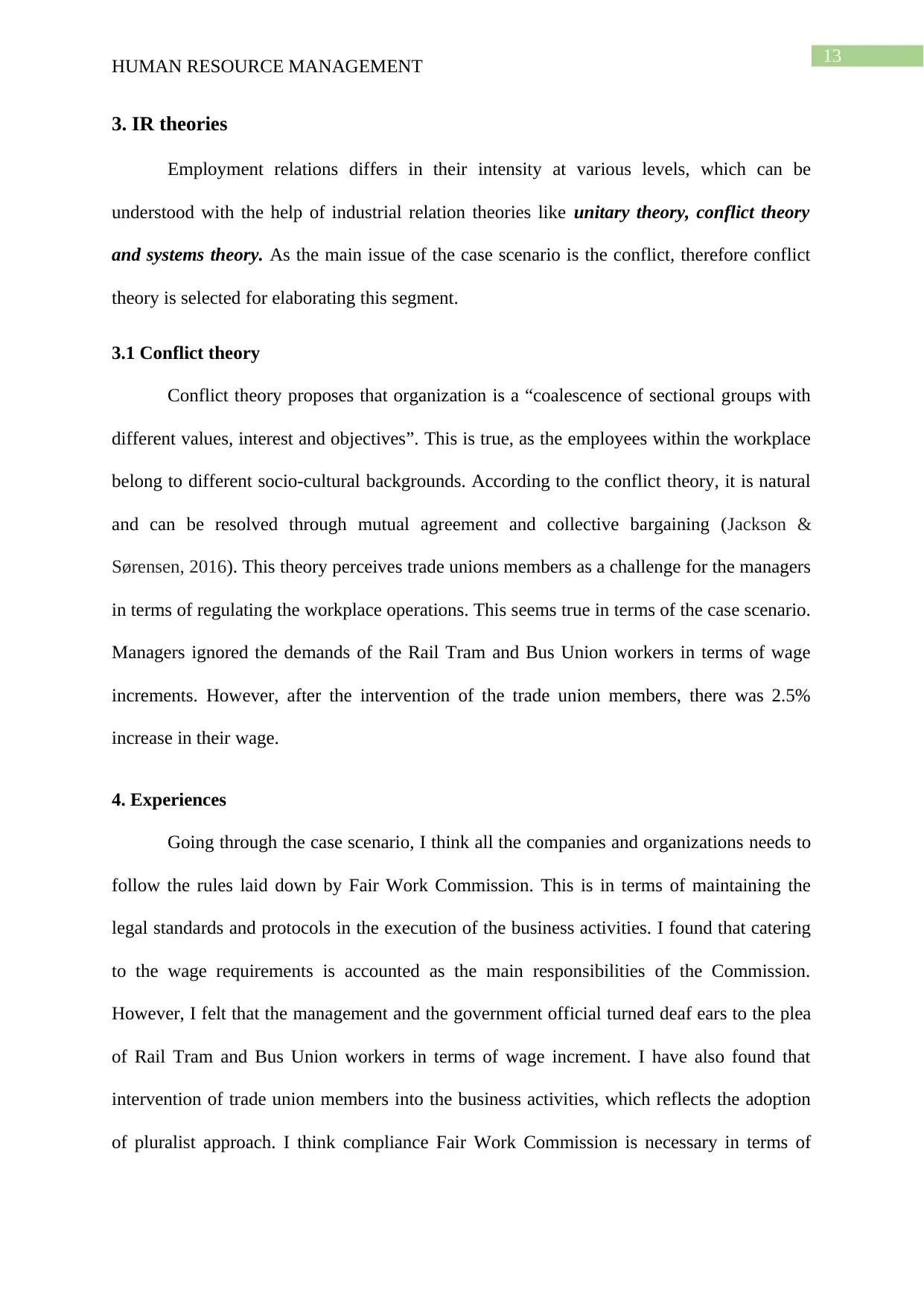
13
HUMAN RESOURCE MANAGEMENT
3. IR theories
Employment relations differs in their intensity at various levels, which can be
understood with the help of industrial relation theories like unitary theory, conflict theory
and systems theory. As the main issue of the case scenario is the conflict, therefore conflict
theory is selected for elaborating this segment.
3.1 Conflict theory
Conflict theory proposes that organization is a “coalescence of sectional groups with
different values, interest and objectives”. This is true, as the employees within the workplace
belong to different socio-cultural backgrounds. According to the conflict theory, it is natural
and can be resolved through mutual agreement and collective bargaining (Jackson &
Sørensen, 2016). This theory perceives trade unions members as a challenge for the managers
in terms of regulating the workplace operations. This seems true in terms of the case scenario.
Managers ignored the demands of the Rail Tram and Bus Union workers in terms of wage
increments. However, after the intervention of the trade union members, there was 2.5%
increase in their wage.
4. Experiences
Going through the case scenario, I think all the companies and organizations needs to
follow the rules laid down by Fair Work Commission. This is in terms of maintaining the
legal standards and protocols in the execution of the business activities. I found that catering
to the wage requirements is accounted as the main responsibilities of the Commission.
However, I felt that the management and the government official turned deaf ears to the plea
of Rail Tram and Bus Union workers in terms of wage increment. I have also found that
intervention of trade union members into the business activities, which reflects the adoption
of pluralist approach. I think compliance Fair Work Commission is necessary in terms of
HUMAN RESOURCE MANAGEMENT
3. IR theories
Employment relations differs in their intensity at various levels, which can be
understood with the help of industrial relation theories like unitary theory, conflict theory
and systems theory. As the main issue of the case scenario is the conflict, therefore conflict
theory is selected for elaborating this segment.
3.1 Conflict theory
Conflict theory proposes that organization is a “coalescence of sectional groups with
different values, interest and objectives”. This is true, as the employees within the workplace
belong to different socio-cultural backgrounds. According to the conflict theory, it is natural
and can be resolved through mutual agreement and collective bargaining (Jackson &
Sørensen, 2016). This theory perceives trade unions members as a challenge for the managers
in terms of regulating the workplace operations. This seems true in terms of the case scenario.
Managers ignored the demands of the Rail Tram and Bus Union workers in terms of wage
increments. However, after the intervention of the trade union members, there was 2.5%
increase in their wage.
4. Experiences
Going through the case scenario, I think all the companies and organizations needs to
follow the rules laid down by Fair Work Commission. This is in terms of maintaining the
legal standards and protocols in the execution of the business activities. I found that catering
to the wage requirements is accounted as the main responsibilities of the Commission.
However, I felt that the management and the government official turned deaf ears to the plea
of Rail Tram and Bus Union workers in terms of wage increment. I have also found that
intervention of trade union members into the business activities, which reflects the adoption
of pluralist approach. I think compliance Fair Work Commission is necessary in terms of

14
HUMAN RESOURCE MANAGEMENT
averting the instances of conflicts. I counter argued the pluralist approach with that of radical
approach. This is in terms of regulating the intervention of the intervention of private owners
like the trade union members.
HUMAN RESOURCE MANAGEMENT
averting the instances of conflicts. I counter argued the pluralist approach with that of radical
approach. This is in terms of regulating the intervention of the intervention of private owners
like the trade union members.
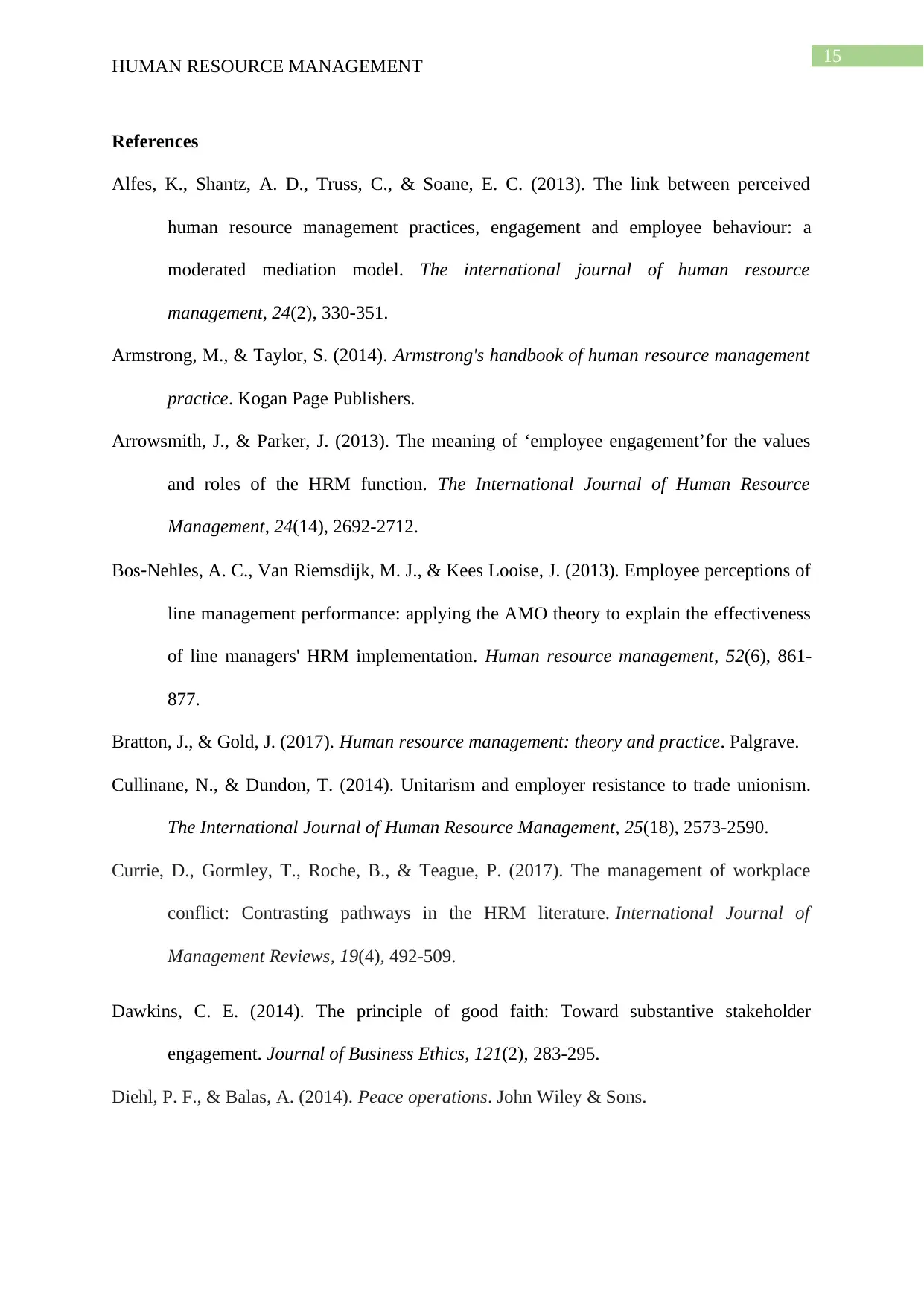
15
HUMAN RESOURCE MANAGEMENT
References
Alfes, K., Shantz, A. D., Truss, C., & Soane, E. C. (2013). The link between perceived
human resource management practices, engagement and employee behaviour: a
moderated mediation model. The international journal of human resource
management, 24(2), 330-351.
Armstrong, M., & Taylor, S. (2014). Armstrong's handbook of human resource management
practice. Kogan Page Publishers.
Arrowsmith, J., & Parker, J. (2013). The meaning of ‘employee engagement’for the values
and roles of the HRM function. The International Journal of Human Resource
Management, 24(14), 2692-2712.
Bos‐Nehles, A. C., Van Riemsdijk, M. J., & Kees Looise, J. (2013). Employee perceptions of
line management performance: applying the AMO theory to explain the effectiveness
of line managers' HRM implementation. Human resource management, 52(6), 861-
877.
Bratton, J., & Gold, J. (2017). Human resource management: theory and practice. Palgrave.
Cullinane, N., & Dundon, T. (2014). Unitarism and employer resistance to trade unionism.
The International Journal of Human Resource Management, 25(18), 2573-2590.
Currie, D., Gormley, T., Roche, B., & Teague, P. (2017). The management of workplace
conflict: Contrasting pathways in the HRM literature. International Journal of
Management Reviews, 19(4), 492-509.
Dawkins, C. E. (2014). The principle of good faith: Toward substantive stakeholder
engagement. Journal of Business Ethics, 121(2), 283-295.
Diehl, P. F., & Balas, A. (2014). Peace operations. John Wiley & Sons.
HUMAN RESOURCE MANAGEMENT
References
Alfes, K., Shantz, A. D., Truss, C., & Soane, E. C. (2013). The link between perceived
human resource management practices, engagement and employee behaviour: a
moderated mediation model. The international journal of human resource
management, 24(2), 330-351.
Armstrong, M., & Taylor, S. (2014). Armstrong's handbook of human resource management
practice. Kogan Page Publishers.
Arrowsmith, J., & Parker, J. (2013). The meaning of ‘employee engagement’for the values
and roles of the HRM function. The International Journal of Human Resource
Management, 24(14), 2692-2712.
Bos‐Nehles, A. C., Van Riemsdijk, M. J., & Kees Looise, J. (2013). Employee perceptions of
line management performance: applying the AMO theory to explain the effectiveness
of line managers' HRM implementation. Human resource management, 52(6), 861-
877.
Bratton, J., & Gold, J. (2017). Human resource management: theory and practice. Palgrave.
Cullinane, N., & Dundon, T. (2014). Unitarism and employer resistance to trade unionism.
The International Journal of Human Resource Management, 25(18), 2573-2590.
Currie, D., Gormley, T., Roche, B., & Teague, P. (2017). The management of workplace
conflict: Contrasting pathways in the HRM literature. International Journal of
Management Reviews, 19(4), 492-509.
Dawkins, C. E. (2014). The principle of good faith: Toward substantive stakeholder
engagement. Journal of Business Ethics, 121(2), 283-295.
Diehl, P. F., & Balas, A. (2014). Peace operations. John Wiley & Sons.
Secure Best Marks with AI Grader
Need help grading? Try our AI Grader for instant feedback on your assignments.
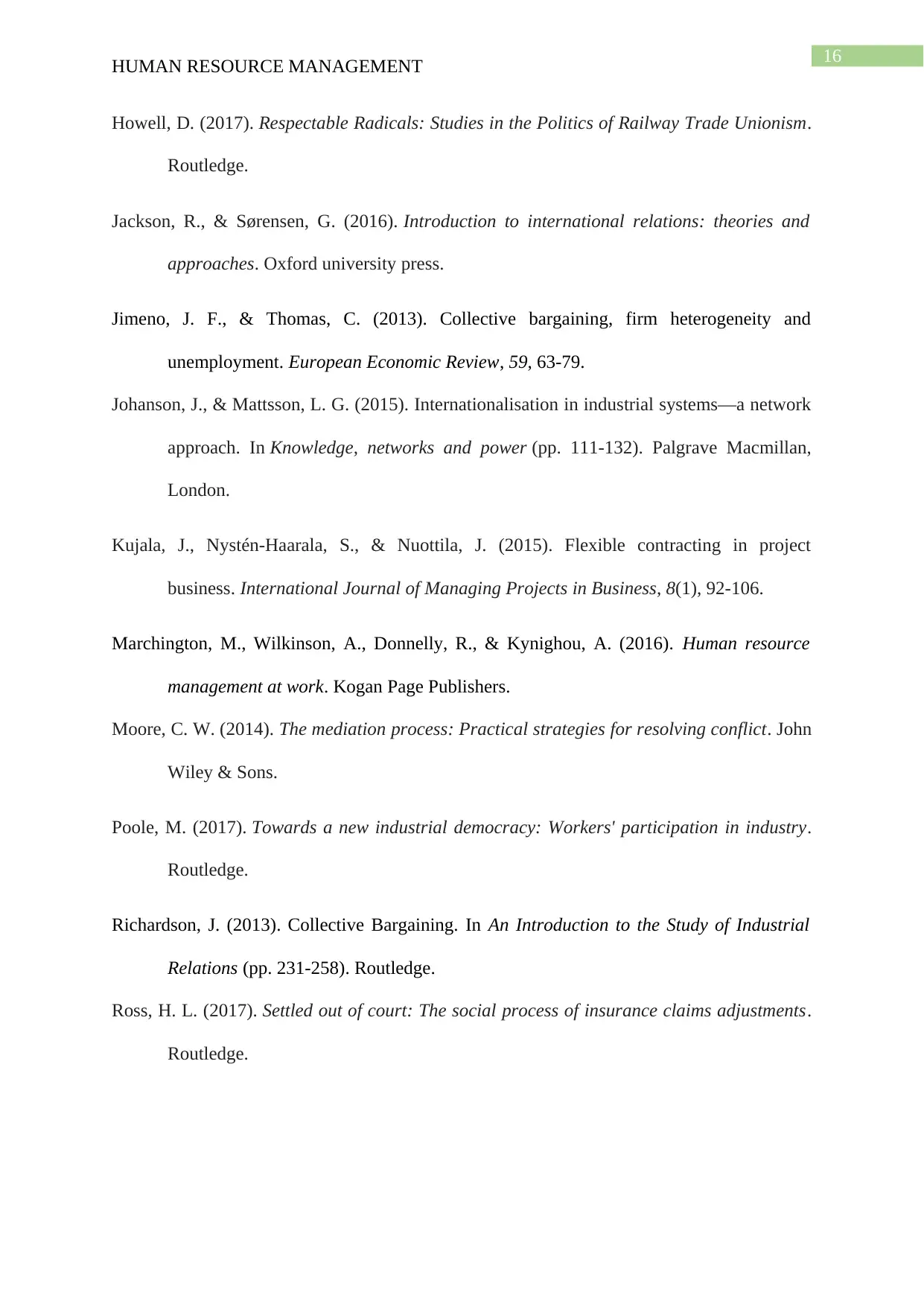
16
HUMAN RESOURCE MANAGEMENT
Howell, D. (2017). Respectable Radicals: Studies in the Politics of Railway Trade Unionism.
Routledge.
Jackson, R., & Sørensen, G. (2016). Introduction to international relations: theories and
approaches. Oxford university press.
Jimeno, J. F., & Thomas, C. (2013). Collective bargaining, firm heterogeneity and
unemployment. European Economic Review, 59, 63-79.
Johanson, J., & Mattsson, L. G. (2015). Internationalisation in industrial systems—a network
approach. In Knowledge, networks and power (pp. 111-132). Palgrave Macmillan,
London.
Kujala, J., Nystén-Haarala, S., & Nuottila, J. (2015). Flexible contracting in project
business. International Journal of Managing Projects in Business, 8(1), 92-106.
Marchington, M., Wilkinson, A., Donnelly, R., & Kynighou, A. (2016). Human resource
management at work. Kogan Page Publishers.
Moore, C. W. (2014). The mediation process: Practical strategies for resolving conflict. John
Wiley & Sons.
Poole, M. (2017). Towards a new industrial democracy: Workers' participation in industry.
Routledge.
Richardson, J. (2013). Collective Bargaining. In An Introduction to the Study of Industrial
Relations (pp. 231-258). Routledge.
Ross, H. L. (2017). Settled out of court: The social process of insurance claims adjustments.
Routledge.
HUMAN RESOURCE MANAGEMENT
Howell, D. (2017). Respectable Radicals: Studies in the Politics of Railway Trade Unionism.
Routledge.
Jackson, R., & Sørensen, G. (2016). Introduction to international relations: theories and
approaches. Oxford university press.
Jimeno, J. F., & Thomas, C. (2013). Collective bargaining, firm heterogeneity and
unemployment. European Economic Review, 59, 63-79.
Johanson, J., & Mattsson, L. G. (2015). Internationalisation in industrial systems—a network
approach. In Knowledge, networks and power (pp. 111-132). Palgrave Macmillan,
London.
Kujala, J., Nystén-Haarala, S., & Nuottila, J. (2015). Flexible contracting in project
business. International Journal of Managing Projects in Business, 8(1), 92-106.
Marchington, M., Wilkinson, A., Donnelly, R., & Kynighou, A. (2016). Human resource
management at work. Kogan Page Publishers.
Moore, C. W. (2014). The mediation process: Practical strategies for resolving conflict. John
Wiley & Sons.
Poole, M. (2017). Towards a new industrial democracy: Workers' participation in industry.
Routledge.
Richardson, J. (2013). Collective Bargaining. In An Introduction to the Study of Industrial
Relations (pp. 231-258). Routledge.
Ross, H. L. (2017). Settled out of court: The social process of insurance claims adjustments.
Routledge.
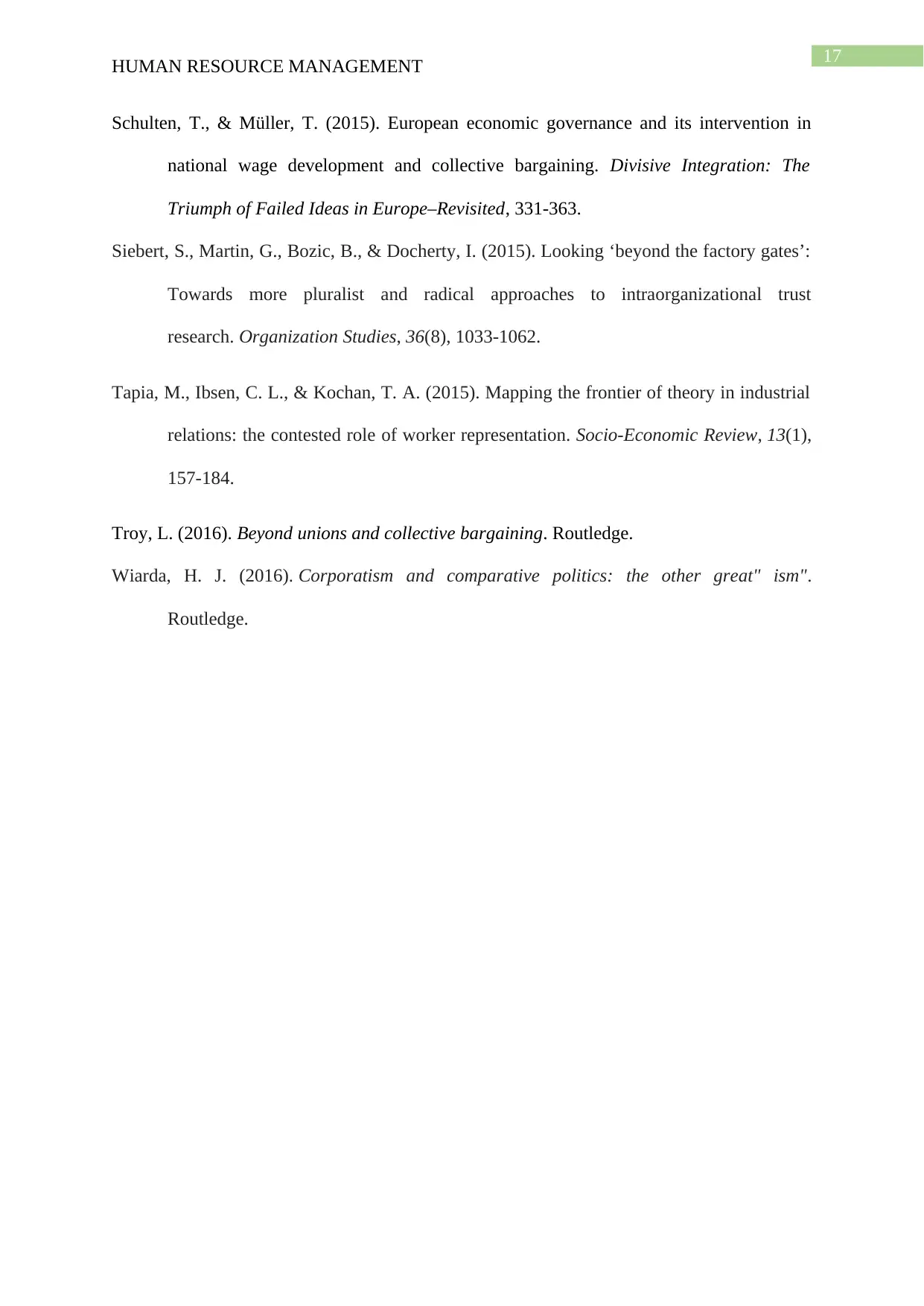
17
HUMAN RESOURCE MANAGEMENT
Schulten, T., & Müller, T. (2015). European economic governance and its intervention in
national wage development and collective bargaining. Divisive Integration: The
Triumph of Failed Ideas in Europe–Revisited, 331-363.
Siebert, S., Martin, G., Bozic, B., & Docherty, I. (2015). Looking ‘beyond the factory gates’:
Towards more pluralist and radical approaches to intraorganizational trust
research. Organization Studies, 36(8), 1033-1062.
Tapia, M., Ibsen, C. L., & Kochan, T. A. (2015). Mapping the frontier of theory in industrial
relations: the contested role of worker representation. Socio-Economic Review, 13(1),
157-184.
Troy, L. (2016). Beyond unions and collective bargaining. Routledge.
Wiarda, H. J. (2016). Corporatism and comparative politics: the other great" ism".
Routledge.
HUMAN RESOURCE MANAGEMENT
Schulten, T., & Müller, T. (2015). European economic governance and its intervention in
national wage development and collective bargaining. Divisive Integration: The
Triumph of Failed Ideas in Europe–Revisited, 331-363.
Siebert, S., Martin, G., Bozic, B., & Docherty, I. (2015). Looking ‘beyond the factory gates’:
Towards more pluralist and radical approaches to intraorganizational trust
research. Organization Studies, 36(8), 1033-1062.
Tapia, M., Ibsen, C. L., & Kochan, T. A. (2015). Mapping the frontier of theory in industrial
relations: the contested role of worker representation. Socio-Economic Review, 13(1),
157-184.
Troy, L. (2016). Beyond unions and collective bargaining. Routledge.
Wiarda, H. J. (2016). Corporatism and comparative politics: the other great" ism".
Routledge.
1 out of 18
Related Documents
Your All-in-One AI-Powered Toolkit for Academic Success.
+13062052269
info@desklib.com
Available 24*7 on WhatsApp / Email
![[object Object]](/_next/static/media/star-bottom.7253800d.svg)
Unlock your academic potential
© 2024 | Zucol Services PVT LTD | All rights reserved.





